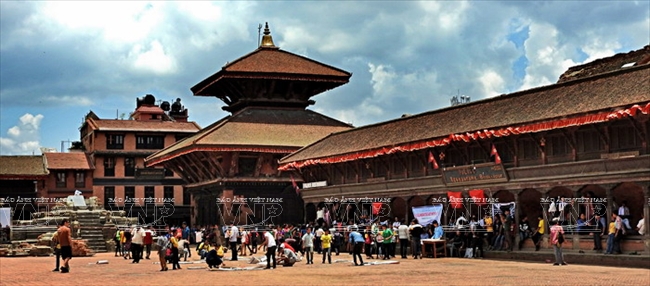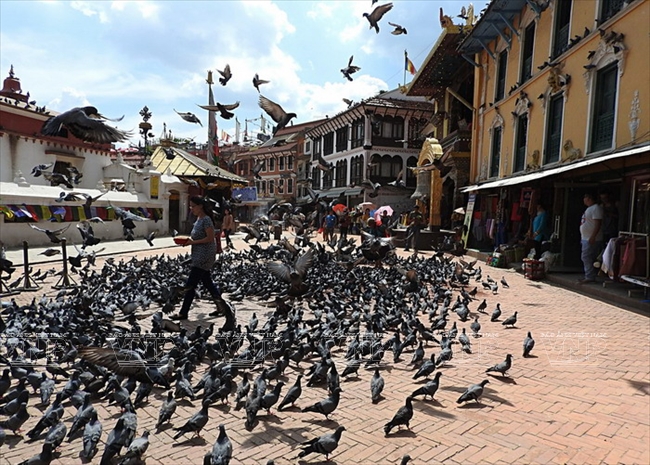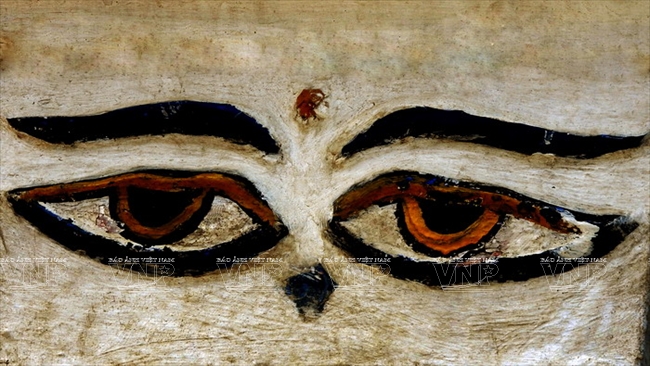Swayambhunath
Swayambhunath, also known as the Monkey Temple, is located on a lush green hill west of the Kathmandu Valley. It is among the oldest religious sites in Nepal, worshiping the Bodhisatva Manjushri. The Swayambhunath complex, with its architecture imbued with Buddhist style, consisted of a stupa and a variety of shrines and temples.
The stupa has a dome at the base, above which is a cubical structure painted with the eyes of Buddha looking in all four directions. There are pentagonal Toran present above each of the four sides with statues engraved in them. Behind and above the torana there are thirteen tiers. Above all the tiers there is a small space above which the Gajur is present. The stupa has many artifacts inside it.
 Kathmandu attracts a large number of visitors all over the world because of mysterious legends and wonderful relics.  A delicate statueon Patan Durbar Square, a World Heritage Site in Nepal.  The imprint of the Padmasambhava’s feet inside Yangleshö Cave.  The temple on Kathmandu Durbar Square was built in the 17th century.  Maya Devi Temple is located at the place where Buddha was born.  Thousands of pigeons on the streets.  Vajra , an indispensable object in Vajrayana ceremonies.  Thangka, a Buddhist painting decorated on Buddhist altars in homes and monasteries.  Praying in a temple in Nepal.  Tibetan Buddhist rite at Boudhanath Stupa.  The Large Triumphal Carriage displayed in Patan, Nepal.  The sacred mountain in Maratika.  Colourful flags for praying of the Tibetans.  Eyes, the symbol of Buddhism in Nepal.  Hanging bells to express respect to Buddha.  Villages on the Himalayas. |
Asura (Yangleshö) Cave is located in the northwest of Kathhmandu. It is believed to be the place where Padmasambhava (Guru Rinpoche) was deep in meditation. The top of the cave is decorated with the picture of Padmasambhava with Mandarava and Yeshe Tsogyel on the two sides.
The cave is a sacred place so it attracts a large number of visitors. It is very interesting to climb to the peak of the mountain above the cave at a height of 4,600m to seek Buddhist scriptures or pray for peace, health and happiness.
Maratika Cave
Maratika is 300km from Kathmandu. Tourists must drive on a very dangerous road to the mountain. It is considered one of six most sacred places of Buddhism in the world. There are smaller caves in Maratika.
Lumbini
Located at the foot of the Himalayas to the southwest of Nepal and near the Indian border, Lumbini is the birthplace of Gautama Buddha. It is the most important sanctuary of Buddhism in Nepal and a famous destination for pilgrimage of Buddhist followers in the world.
Lumbini is separated into the eastern and western monastic zones with the Theravadin monasteries and the Mahayana and Vajrayana monasteries respectively. The holy site still preserves relics of ancient monasteries, a sacred Bodhi tree, an ancient pond, the Ashokan pillar and the Mayadevi Temple, where Buddha was born.



